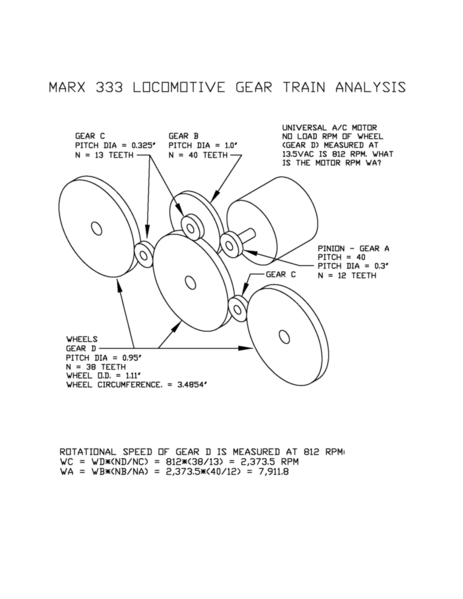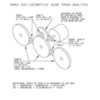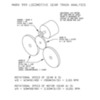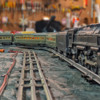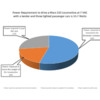I did some bench testing and conducted some time trials with my Marx 333 Hudson-type 4-6-2 locomotive. The 333 is probably the finest locomotive that Marx produced. It weighs 2 lbs and 6.4 ounces.
My test rig, instrumentation and methods are described above.
I first bench tested the locomotive at 7 VAC, and the motor's amp draw was 1.14A, 7.98 Watts. Bench testing like this allows me to get a good idea of how much power it takes just to overcome the combined friction loss of the drivetrain.
I ran the locomotive only on the track described above, and measured the elapsed time to cover 5 laps, while also measuring the amperage, at 5, 6, 7, and 8 VAC. I did not go outside this range because the locomotive wouldn't run consistently at voltages less than 5, and would run dangerously fast at voltages greater than 8. My results are:
Without tender or passenger cars
| TRACK VOLTAGE | Elapsed Time MIN | Speed FPM | Speed MPH | Scale MPH | Motor RPM | Amps | Power Watts |
| 5 | 1.8376 | 36.5787 | 0.42 | 26.6 | 1227.1 | 1.32 | 6.6 |
| 6 | 0.7698 | 87.3141 | 0.99 | 63.5 | 2929.1 | 1.5 | 9 |
| 7 | 0.5892 | 114.0896 | 1.30 | 83.0 | 3827.3 | 1.53 | 10.71 |
| 8 | 0.4853 | 138.4975 | 1.57 | 100.7 | 4646.1 | 1.6 | 12.8 |
I then ran the locomotive with its diecast tender and three lighted passenger cars on the track described above, and measured the elapsed time to cover 5 laps, while also measuring the amperage, at 7, 8, 9, 10, 11, and 12 VAC. I did not go outside this range because the locomotive wouldn't run consistently at voltages less than 7, and would run dangerously fast at voltages greater than 12. My results are:
With tender a three passenger cars:
| TRACK VOLTAGE | Elapsed Time MIN | Speed FPM | Speed MPH | Scale MPH | Motor RPM | Amps | Power Watts |
| 7 | 1.1013 | 61.0342 | 0.69 | 44.4 | 2047.5 | 2.1 | 14.7 |
| 8 | 0.7482 | 89.8431 | 1.02 | 65.3 | 3013.9 | 2.2 | 17.6 |
| 9 | 0.6316 | 106.4234 | 1.21 | 77.4 | 3570.1 | 2.35 | 21.15 |
| 10 | 0.5602 | 119.9961 | 1.36 | 87.3 | 4025.5 | 2.45 | 24.5 |
| 11 | 0.4920 | 136.6199 | 1.55 | 99.4 | 4583.1 | 2.5 | 27.5 |
| 12 | 0.4488 | 149.7705 | 1.70 | 108.9 | 5024.3 | 2.63 | 31.56 |
It is interesting to compare and contrast the results when the 333 locomotive was operated at 7 VAC. On the bench, the power requirement was 7.98 watts. On the track without anything in tow, the power requirement was 10.71 watts. On the track with a tender and three passenger cars in tow, the power requirement jumped up to 14.7 watts.
The 333 runs slower than the 999, it is more powerful, and operates within a wider range of voltages. The 333 however, does not run very well on 0-27 tracks because the turns are too tight and the drive wheels get hung up, loose adhesion, and start spinning. Other differences between the 333 and the 999 - the 333 has smaller diameter drive wheels, so at comparable rpms, the 333 will run slower than the 999. The 333 has a gear ratio of 9.74 to 1. while the 999 has a gear ratio of 5.4 to 1. The 999's motor runs at much higher rpms than the 333. See my tachometer readings above.
One other observation, it takes a good deal of power to pull the lighted passenger cars - because of the rolling resistance of the wheels, and because of the resistive friction of the lighting pickups. I did some interesting testing of the rolling resistance of my train cars and I produced some interesting data which I will provide in a follow-on posting.
One final note on my 333 - it does not have an e-unit ( I physically removed it) and the headlight is an E10, 24V cold-white LED screw-type bulb. So my locomotive is running a little more efficiently than a stock 333.






